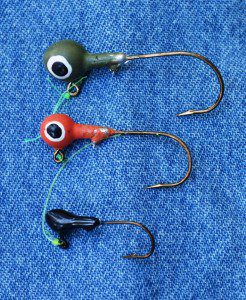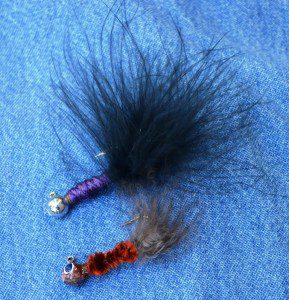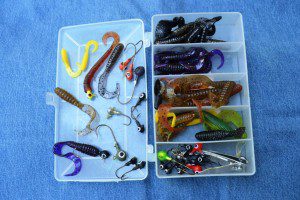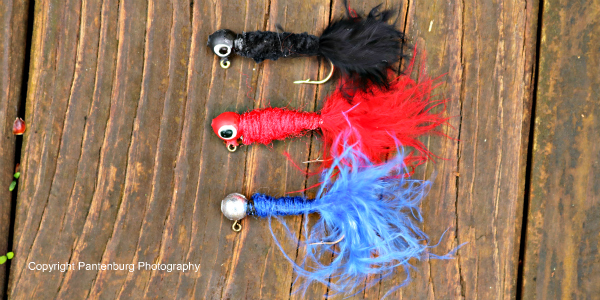Is there a do-it-all lure for survival fishing? My money is on the plain lead head jig. Here’s why.
by Leon Pantenburg
After my first week on the Mississippi River, I sent three fishing rods and a large tackle box home. After seven days of fishing and catching many walleye, smallmouth bass, northern pike, crappie and bluegills, I didn’t anticipate needing anything but a medium-action, fast-tip, seven-foot spinning rod, a Mitchell 300 reel with six-pound line and a box of spinners and leadhead jigs.

The basis of a very effective group of survival fishing lures is the simple, leadhead jig. From top is a 1/4, 1/8 and 1/16 ounce jig (Pantenburg photos)
This selection served me well the rest of the way down the 2,500 miles of the river. I never went hungry because I couldn’t catch a fish and my go-to lure was a 1/8-ounce jig, tipped with a three-inch yellow Mr. Twister.
When putting together a survival kit, you must to carefully weigh the value of the components. A common question is about fishing lures: Is there one lure that can catch everything?
First, though, remember that survival fishing is not sport fishing. If you must catch fish to survive, use the most effective method available, legal or not.
Hook and line sport fishing techniques may not be particularly effective in a survival situation. In fact, it may be a waste of really valuable time if you’re fishing when a better choice might be to gather firewood, improve a shelter, or set up signals. You also need to figure out the return on your calorie investment. If you must expend 300 calories to catch a fish that can only supply 100 calories, you’re going to end up with an energy deficit.
So the choice of the best survival lure depends on the situation, location and water conditions. Talk to several fisherpeople and you’ll probably get that many opinions.
My best all-around nomination is for the leadhead jig, and here’s why:
Inexpensive: The jig is nothing more than a hook with a gob of lead near the eyelet. I pour my own, ranging in weight from 1/32-ounce to 1/4-ounce, in several styles. Several years ago, the guys in the print shop at the newspaper gave me about 20 pounds of old linetype lead. My jigs cost the price of the hooks, and whatever electricity it takes to run my melting pot.

These 1/8-ounce jig lures were improvised. The bodies are wool yarn. The top lure tail is a marabou feather, and the bottom tail a pheasant feather. Both patterns are proven and effective.
You can buy bulk leadheads at any sporting goods store, and the bodies are so inexpensive, you can stock up on different colors, styles and sizes.
Versatile: I tip jigs with virtually anything, from plastic twister tail grub bodies, to hair and feathers. Since I hunt, I have a lifetime supply of deer, elk and squirrel tails, and the feathers from a variety of game birds. Depending on the species of fish and circumstances, I can make just about any type of jig necessary. Part of the fun of fishing is catching something on a homemade lure!
Effectiveness: The jig is designed to mimic a minnow, or represent some other food source. Sometimes, a properly-fished jig will cause a reflexive strike for a game fish. While I have a tackle box full of various lures, I generally start out with a jig, and seldom have reason to switch.
Color: Start out with a basic selection of black, white and chartreuse, and those colors will probably do the job. My favorite color on the Mississippi River was yellow. My top producer color on Oregon’s John Day River is motor oil or brown. Black and white are always contenders. Experiment in your area, and you’ll be able to dial in the local color preferences.

This pocket-sized box holds all the lures I need for a day of smallmouth bass fishing on Oregon’s John Day River.
Fishing technique for a jig can depend on the circumstances. The most effective method, IMHO, is to cast the lure out, and bounce it off the bottom. You will lose a lot of jigs like this, but if you aren’t hitting snags or rocks, you aren’t prospecting where the fish are. I like a medium-action spinning rod with a fast tip for most jig fishing. Lightweight fishing rods seem to work best.
Another method is a steady retrieve, with periodic twitches. A favorite panfishing method that also works well for steelhead trout is to attach a jig a few feet under a bobber or float.
Like any survival technique, the more you practice, the more effective you will be. And to be required to practice fishing…well, worse things can happen!
Please click here to check out and subscribe to the SurvivalCommonSense.com YouTube channel – thanks!


Leave a Reply